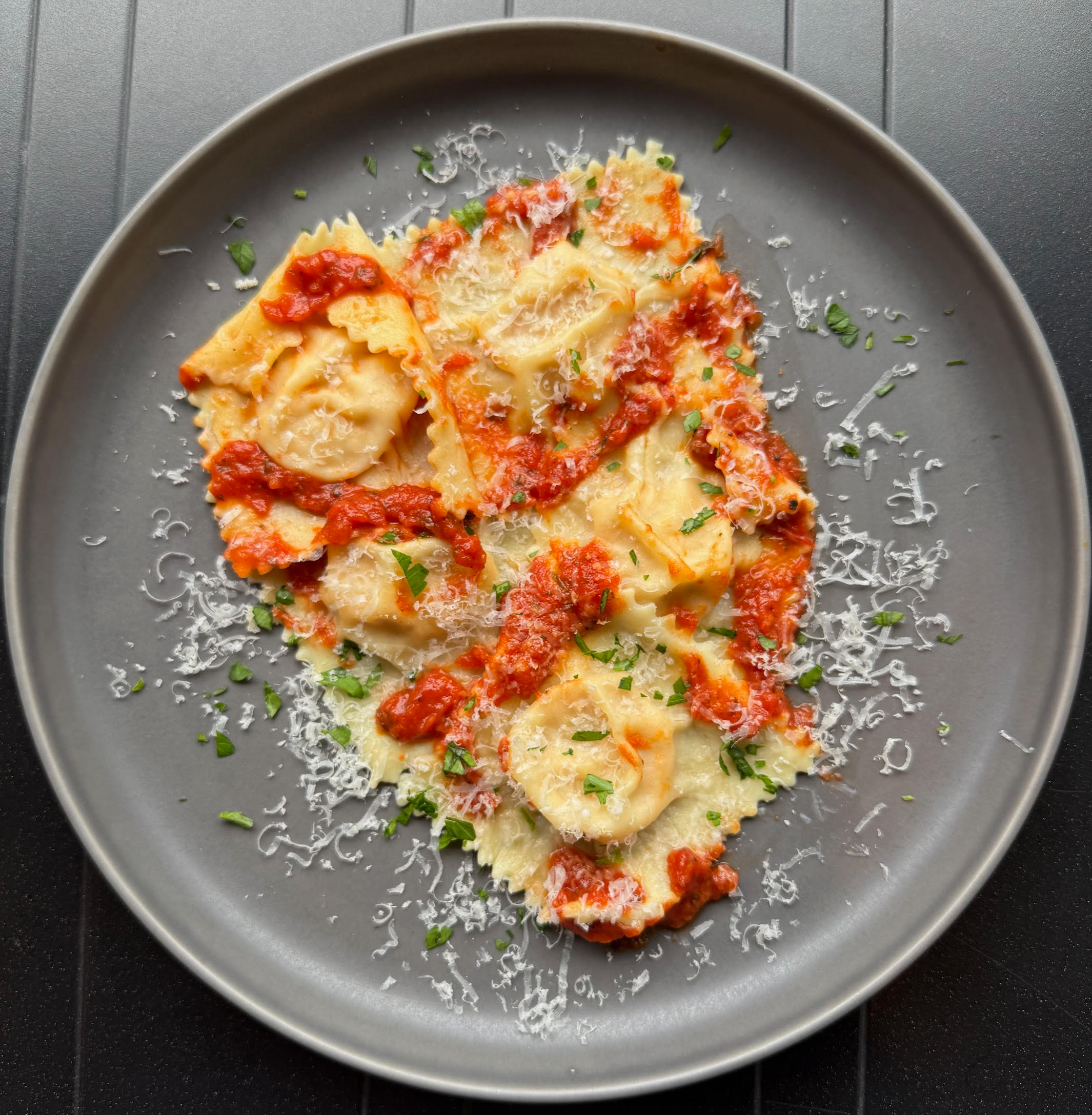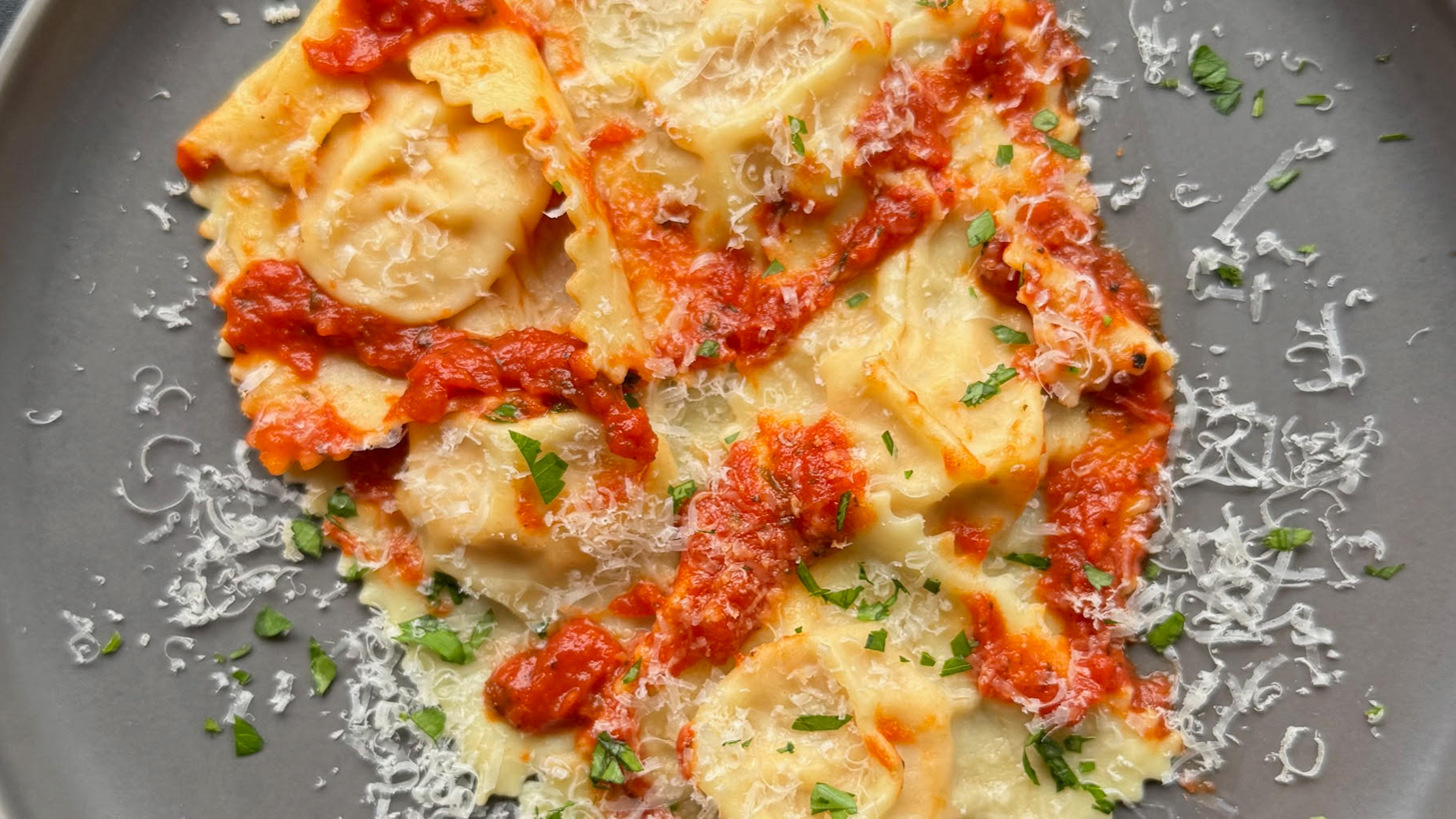We eat a lot of salmon at our house. My wife Julie considers salmon to be its own food group! My goal was to combine my love of homemade pasta with lightly smoked salmon that, unlike traditional smoked salmon, needs to be cooked and remains tender and gently flavorful. I came up with a light, elegant dish that is perfect for a special dinner.
I was thinking about using ricotta for the filing, but decided that mascarpone would add extra richness to the dish. There is something really special to me about making homemade ravioli. It connects me with my family – it’s equal parts craft, tradition, and indulgence. Making fresh pasta is worth the effort as it connects you to generations of cooks who have done the same. These ravioli, stuffed with lightly smoked salmon, mascarpone, lemon and dill are little packages of care. They are luxurious and nutritious to boot, as salmon adds protein and omega-3s to your diet.

Shaping and filling ravioli
Ravioli starts with a simple dough and specialized equipment is not required. Use “00” flour if you have it, otherwise all-purpose is fine. Figure about 100 g flour per large egg; add a pinch of salt and a few drops of water only if the dough feels tight. Knead until smooth and springy, then wrap and rest 30–60 minutes so the gluten relaxes. While it rests, make sure your filling is cool and not watery. A drier filling is easier to seal and cooks more neatly.
If you’re rolling by hand, divide the dough and keep the pieces you’re not using covered. Lightly flour the counter and roll from the center out, turning and flipping so it doesn’t stick. Aim for thin enough that you can see the shadow of your hand through the sheet. With a pasta maker, start on the widest setting and run the dough through several times, folding in thirds until the sheet looks smooth and even. Then step down one notch at a time to about #6 on most machines, roughly 1 mm thick. Dust with a little flour as you go, but don’t overdo it or the sheets won’t seal.
Molds make shaping fast and uniform. Dust the mold and lay a sheet over it, pressing gently to form shallow wells. Spoon small mounds—about 1–11⁄2 teaspoons—into the wells, keeping a clean border. Brush the borders lightly with water or a thin egg wash, cap with a second sheet, and run a rolling pin over the mold to press and cut. Invert the mold, release the ravioli, and check that each seam is fully sealed. Without a mold, work on a floured board. Lay a sheet down, space neat mounds in rows, moisten the borders, and top with a second sheet. Using your hand, press around each mound to push out
air. Cut with a sharp knife, fluted wheel, or round cutter for mezzaluna shapes. Transfer to a semolina-dusted tray and keep covered with a towel as you work.
Cook ravioli in well-salted, gently simmering water so they don’t burst in turbulence. Fresh ravioli usually take 2–4 minutes after they float; frozen go a minute or two longer. Lift with a spider and finish in a wide pan with butter, olive oil, or a light sauce, loosening with a splash of pasta water. If you’re making them ahead, freeze in a single layer on the tray, then transfer to a sealable bag once firm. ![]()
Ingredients
For the filling:
- •Two 284g (10-ounce) packages Ducktrap Lightly Smoked Salmon fillet
- •Oil, for baking sheet
- •227g (8 ounces) mascarpone
- •Finely grated zest of 1 lemon
- •½ teaspoon dried dill or 1 tablespoon minced fresh dill
- •1⁄2 teaspoon fine salt
- •Pepper, to taste
For the pasta:
- •400g (14 ounces) 00 or all-purpose flour
- •Fine salt, as needed
- •4 large eggs
- •1 tablespoon extra-virgin olive oil
To finish and serve::
- •About 473 ml (2 cups) of your favorite marinara sauce, purchased or homemade
- •Shaved or grated Parmigiano Reggiano, to taste
- •Fresh basil, shredded or chopped, for garnish


Preparation
For the filling: Preheat the oven to 204 degrees C (400 degrees F). Bake unseasoned salmon on an oiled baking sheet, skin-side down, for 17 minutes.
Once cooled, remove the skin from the salmon. In the bowl of a food processor, combine the fish, mascarpone, lemon zest, dill, salt, and pepper. Process until it becomes a smooth, mousse-like consistency; set aside while making the pasta.
For the pasta: In a large bowl, mix the flour and 1 teaspoon salt using a fork. Create a well in the center. Crack the eggs into the well and add the olive oil and salt. Beat the eggs and olive oil with a fork and, using your fingers, slowly mix the eggs into the flour until you are left with one large lump of dough. Remove the dough ball and knead for 5-7 minutes, or until it becomes a smooth elastic ball. Wrap in cling film and allow to rest for 20 minutes.
Cut the dough into quarters. If using a pasta machine, roll out pasta sheets to desired thickness (#6 or #7). Alternatively, roll out the dough thinly using a rolling pin on a lightly floured surface.
Cut each rolled sheet into two sections. On one of the sheets, spoon out about 1 or 2 teaspoons of the salmon filling at regular intervals. Five cm (2-inch) squares are a standard size but you can make the ravioli any size you like. Brush the edges of the pasta with water and place a second sheet on top of the first, squeezing out any air bubbles. Press together, seal, and cut out the individual ravioli using a pasta cutter. Cover the ravioli with a towel to prevent them from drying out, and continue the same process using the remaining dough and filling.
Fill a large pot with water and about 1 tablespoon salt, and bring to a low boil. Add the ravioli and cook until al dente, about 3-4 minutes. Once cooked, remove from the pot, drain, and serve topped with your favorite marinara sauce. Garnish with shaved or grated Parmigiano reggiano and basil.

